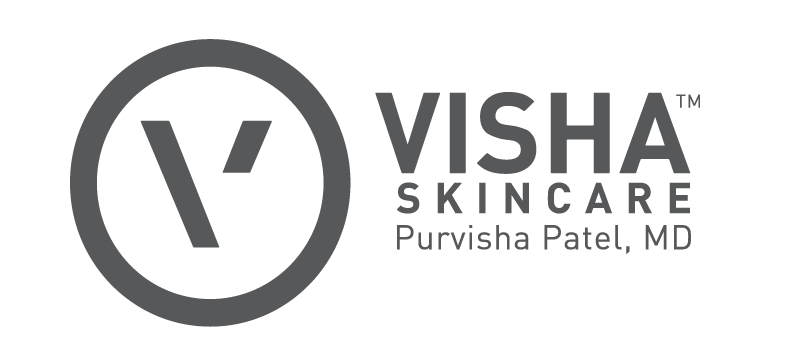
Teen Vogue posted "How to Make Sure Your Halloween Makeup Doesn't Cause Skin Issues" featuring Dr. Purvisha Patel.
The article includes Dr. Patel's expert commentary on the dangers of thick makeup!
If there's an ideal day of the year to go all out with your makeup, it's Halloween. When else can you slather your face in goop and red food coloring and call it a #lewk? But while face paint and fake blood can be 💯 for terrifying your friends, it isn't exactly great for your skin.
Because a lot of Halloween costumes require something heavier than the usual foundation or tinted moisturizer your pores are used to, it can create some pretty frustrating face issues if you aren't careful. "These heavier products can clog the pores and cause allergic reactions," says dermatologist Dr. Purvisha Patel, creator of Visha Skin Care. This can translate to pimples, blackheads and rashes... none of which will be fun to wake up to aside your candy stash on November 1st.
Whether you'll be ringing in October 31st as a glitter-y mermaid or "IT," read on for dermatologist-approved tips on how to make sure your skin doesn't have a scary reaction to anything you pile onto it.
Read The Ingredients
Even though you'll only be wearing your makeup costume for one night, it's still important to know what you're putting all over your face. "Heavy stage makeup is certainly more likely to clog your pores than an everyday foundation. This is because it is thick, difficult to wash off, and can have other harsh ingredients that give good coverage, but irritate skin," says Dr. Michele Farber of Schweiger Dermatology Group in New York. "Think preservatives and fragrances that may cause allergic reactions and heavier oils than regular makeup." If you do wear a thick makeup, know what to pick. We recommend artist-approved brands like Ben Nye, Mehron, Make Up For Ever, or MAC.
Don't Recycle Last Year's Halloween Makeup
Sure, you may not have touched your white face paint since last year's vampire costume, but it's best to think twice before repurposing it for this year's terrifying "IT." "You want to be sure that there hasn't been enough time for bacteria to accrue on the makeup, so that way you aren't going to contaminate the skin," says Dr. Patel. "Products, such as makeup and creams that are not used, can incubate bacteria over a course of time. It can happen especially in Halloween makeup as it can go untouched for a year between use." A warm, dark container is the perfect breeding ground for bacteria — especially when it stays closed for a long period of time. If the makeup starts to smell bad, it's probably because it's old and full of bacteria (ew), so you should definitely toss it and grab a new pack.
Makeup expiration dates are real, people, so ignore them at your own risk.
Do A Spot Test
Sure, a face full of hives might make your costume slightly more terrifying, but let's go ahead and assume that no one is looking to go as a skeleton with an allergic reaction this year. Before you rub something all over your face, Dr. Patel advises doing a spot test on the back of your hand or your arm. And if all looks clear, go ahead and give yourself a trial run a few days before Halloween to make sure you've totally perfected those mermaid scales.
Prep Your Face Properly
Putting new makeup on top of dirty skin (or worse, a layer of old makeup) is bad practice in every day life, and it's even worse when you're using the hardcore stage stuff. Be sure to give your skin a solid once-over right before applying any sort of new makeup, then apply on a layer of moisturizer to keep it from clogging your pores. "If you are more acne-prone or have more sensitive skin, you’ll want to use a non-comedogenic cream to moisturize before your makeup, and be sure to check for oil-free or non-comedogenic on the label of your foundation products to prevent a big break out," says Dr. Farber. "Adding a gentle primer can also achieve the desired look without damaging skin."
Invest In Adhesive Remover
If you're going to be sticking anything to your face — whether it's false lashes or one of those creepy, bloody prosthetics — it's important that you have the right tools to remove them properly. When the trick-or-treating is over and it comes time to say goodbye to your costume, these should be the first things to come off. Make sure you pick up an actual adhesive remover, like this one, paired with a warm water-soaked cotton ball and rubbing alcohol if you need a little extra de-sticking. If you have sensitive skin, plan to be extra careful before gluing anything to your face because you'll be more prone to irritation and allergic reactions. "If your skin is sensitive but you’re pumped about your Halloween costume, look for water-based adhesive products for application," says Dr. Farber. "Also, don’t try to take anything off by yourself — first use a gentle foaming facial cleanser, non-comedogenic moisturizer, then follow it with the adhesive remover."
Triple Wash Before Bed
When it comes to Halloween makeup, the worst thing you can do is skip out on washing your face before bed. Not only will you wake up with a creepy clown imprinted into your pillowcase, but your poor pores will seriously pay the price in the coming days. Dr. Patel suggests a three-step cleansing routine in order to make sure things really are all clear. First, start with a regular gentle cleanser. Then, use makeup remover or baby oil to remove any remaining makeup residue from your eyes. Finally, exfoliate with cleanser and a wash cloth to be sure everything is squeaky clean. Give yourself one last rubdown with a cotton ball dipped in toner, then slap on some moisturizer before passing out into a candy-induced coma.
